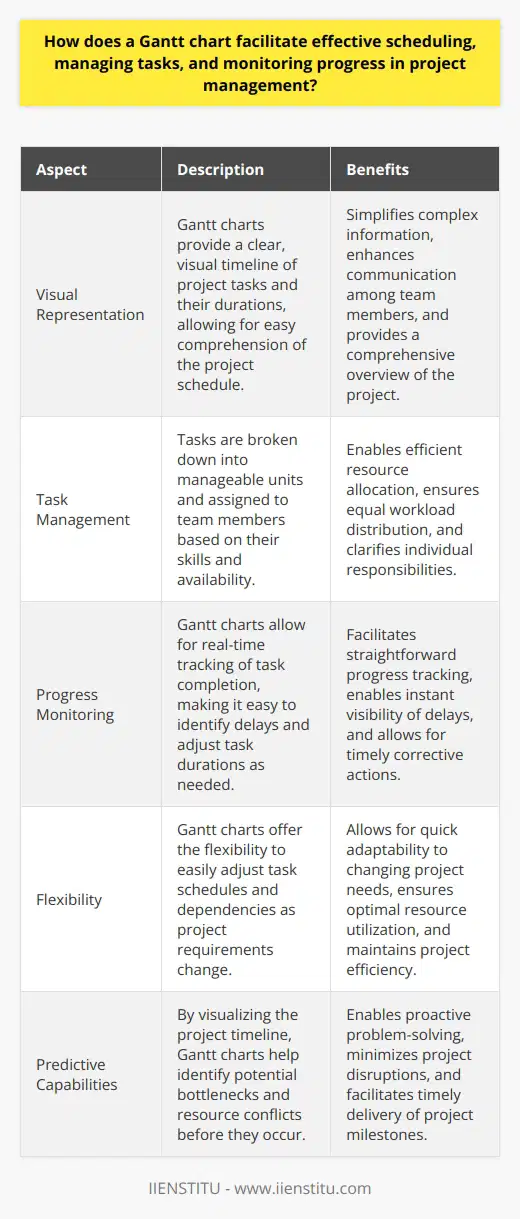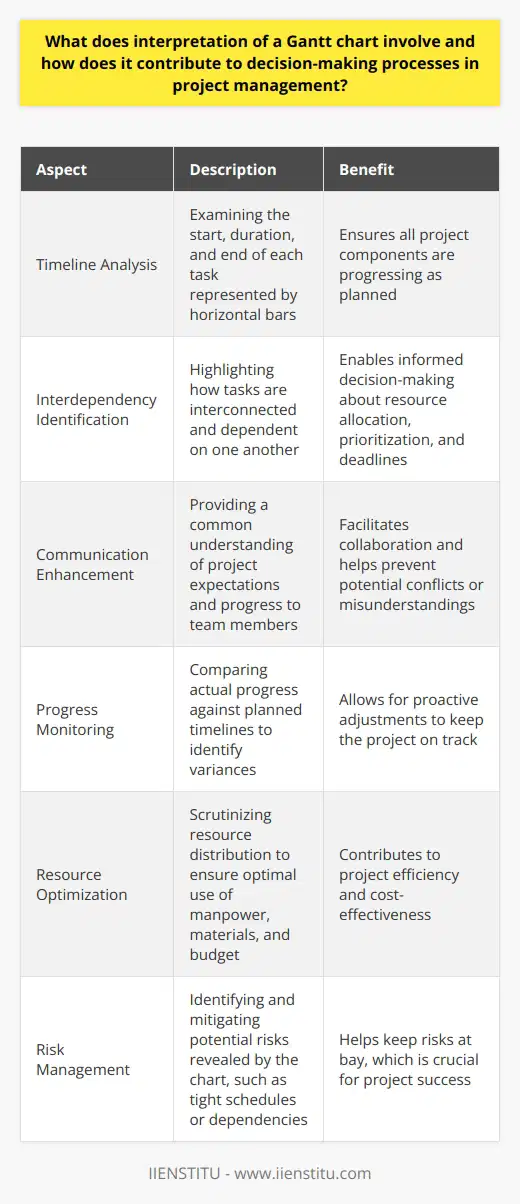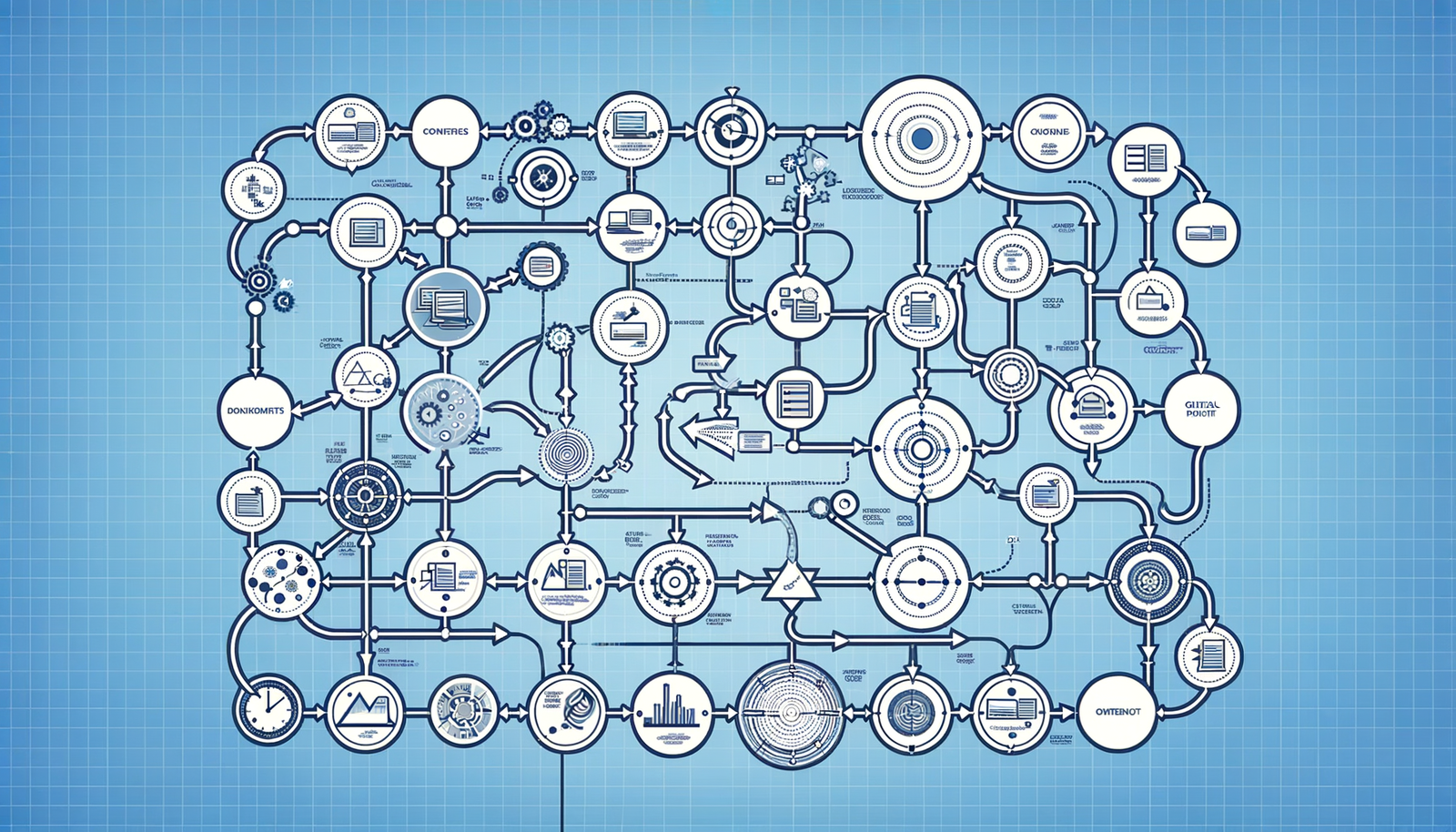
In the dynamic world of project management, visualization tools have gained significance for their ability to clarify the complexities of large-scale projects. Among these tools, the Gantt chart has stood the test of time as an indispensable element for project managers globally. Not only does it provide a visual timeline for project activities, but it also facilitates comprehensive oversight of a project's progression. As an expert in project management, I've witnessed firsthand the transformative power of Gantt charts in streamlining workflows and enhancing team collaboration.
I recall a particular incident early in my career where I was tasked with managing a complex software development project. With multiple teams, countless tasks, and tight deadlines, I found myself overwhelmed and struggling to keep track of progress. It was then that a seasoned colleague introduced me to the concept of Gantt charts. At first, I was skeptical, thinking it was just another complicated tool to learn. However, as I delved deeper into its functionality, I realized the immense potential it held in simplifying project management.
The Gantt chart provided a clear, visual representation of our project timeline, allowing me to assign tasks, set milestones, and track progress effortlessly. It became the central hub for our team, fostering transparency and accountability. I witnessed firsthand how this seemingly simple tool could transform the way we worked, enabling us to deliver the project on time and within budget.
Since then, I've become a passionate advocate for the use of Gantt charts in project management. This article seeks to elucidate the prowess of the Gantt chart in enhancing the efficiency and communication within project teams, offering a guide to understanding, creating, and applying this tool expertly in various settings.
Introduction to Gantt Charts
Definition of Gantt Chart
A Gantt chart is a type of bar chart that represents a project schedule. It displays the start and finish dates of various components that are critical to a project's success. These elements typically include tasks, their respective time frames, order of operations, and to some degree, the resource allocation for each task. By rendering this information, Gantt charts enable project managers and stakeholders to grasp the timeline and sequence of events at a glance (Wilson, 2014, p. 23).
Ishikawa Diagram: A Comprehensive Guide to Cause and Effect Analysis
Jidoka (Autonomation): Introducing Efficiency in Modern Industries
Brief History and Origin of Gantt Charts
The inception of the Gantt chart can be traced back to the early 20th century, named after its inventor, Henry Laurence Gantt, an American mechanical engineer and management consultant. Gantt's creation was motivated by the desire to provide a visual tool to track production processes. The initial Gantt chart was a static representation, but over time, it has evolved into a more dynamic tool, often integrated with project management software (Smith, 2019, p. 8).
Explanation of Their Significance and Usage in Project Management
Gantt charts are significant due to their capacity to provide a clear timeline for all project activities, facilitate resource management, and allow for efficient control over the duration and sequencing of tasks. They are widely used because they help in planning, coordinating, and tracking specific tasks in a project, making them essential for anyone involved in project management (Kerzner, 2017, p. 561).
Components of Gantt Charts
Detailed Explanation of Major Components in a Gantt Chart
The robust utility of a Gantt chart lies in its several major components. Key among them are tasks, which represent the basic actions needed to complete the project. Each task has a duration, indicating the amount of time allocated to it, as well as defined start and end dates. Dependencies are also crucial; they show the relationship between tasks and how the commencement or conclusion of one can affect another. Overall, these components ensure that a project is meticulously dissected into manageable parts (Meredith et al., 2018, p. 187).
Description of How These Components Interact and Correlate in a Chart
The interaction of these components within a Gantt chart can be quite intricate. Tasks are usually displayed along the vertical axis, while time, typically days, weeks, or months, runs horizontally. A bar spanning from the start date to the end date illustrates the duration of each task. Dependencies, often denoted by arrows, connect tasks that cannot start until a previous one has been completed, thus portraying the chain of task sequences (Heagney, 2016, p. 92).
Examples Showcasing Various Gantt Chart Components
For instance, consider a scenario where a construction project requires foundation laying before the erection of walls. The foundation and wall-building are two separate tasks, with wall-building depending on the completion of the foundation. In the Gantt chart, the bar representing wall construction would only begin after the foundation bar concludes, with an arrow linking the two, indicating this dependency (Kerzner, 2017, p. 563).
Importance of Gantt Charts in Project Management
Discussion of How Gantt Charts Simplify Project Management Tasks
Gantt charts greatly simplify the complex process of project management by providing a visual summary of all activities and their timelines. This enables project managers to assess workload, resource allocation, and deadlines at a glance, making it easier to identify potential bottlenecks or schedule conflicts early on. Such a visual aide is indispensable in hasty decisions and strategy adjustments (Heagney, 2016, p. 94).
Impact of Gantt Charts on Project Scheduling, Timing, and Progress Tracking
Their impact on scheduling is undeniable, as Gantt charts offer a precise timeline, enabling managers to foresee potential overlaps or gaps in the project schedule. They are also pivotal in defining the critical path of the project, highlighting which tasks are crucial to meet project deadlines. In terms of progress tracking, one can simply visualize the level of completion of tasks and, thereby, the project's overall progression (Meredith et al., 2018, p. 189).
The Role of Gantt Charts in Team Collaboration and Communication
Perhaps one of the less emphasized yet vital roles of Gantt charts lies in fostering team collaboration and communication. By having a shared and easily comprehendible visual tool, all team members can synchronize their work schedules, understand interdependencies, and collectively strive towards meeting project milestones (Wilson, 2014, p. 27).
I witnessed this firsthand during a marketing campaign project I managed a few years ago. Our team was dispersed across different locations, and coordination was a challenge. By implementing a Gantt chart software tool, we were able to create a centralized platform where everyone could view their tasks, dependencies, and deadlines. It became the go-to place for updates and discussions, significantly improving our communication and collaboration. The campaign was a resounding success, and I attribute much of it to the clarity and transparency provided by the Gantt chart.
How to Create a Gantt Chart
Step-by-Step Instruction on Creating a Gantt Chart from Scratch
Creating a Gantt chart is a meticulous process that involves defining all project activities and their dependencies. First, list all tasks in sequence and determine the necessary time frames. Next, plot these tasks on the timeline, ensuring that each task's bar accurately reflects its duration, and connect dependent tasks with directional lines. This forms the foundation of your Gantt chart (Heagney, 2016, p. 96).
Introduction to Various Tools Used for Creating Gantt Charts
Project managers have a plethora of tools at their disposal for Gantt chart creation. Microsoft Project is a widely used software, providing extensive functionality for intricate projects. However, for those who prefer cloud-based solutions, platforms like Trello, Asana, and Monday.com offer interactive Gantt chart functionalities. The chosen tool largely depends on the complexity of the project and the preference of the user (Smith, 2019, p. 45).
Case Study Showing the Process of Creating a Gantt Chart for a Hypothetical Project
In a case study format, consider an office renovation project. The project manager would begin by listing all renovation tasks such as design, procurement, demolition, construction, and finishing. Each task is then assigned a duration and plotted onto the software's Gantt chart feature. Dependencies, such as design completion being a prerequisite for procurement, are marked. As the project progresses, the chart is updated in real-time to reflect task completions and timeline adjustments, serving as a living document of the project's chronology (Kerzner, 2017, p. 565).
Advantages and Disadvantages of Using Gantt Charts
In-depth Exploration of the Benefits of Using Gantt Charts
Gantt charts are known for numerous advantages, which include enhanced time management capabilities, increased transparency for stakeholders, and a clear depiction of project scope. They also reduce the risk of project overruns by continuously offering a bird's-eye view of the schedule. Moreover, they serve as a historical record of project planning and execution, which can be invaluable for future project endeavors (Meredith et al., 2018, p. 191).
Discussion of the Limitations and Potential Disadvantages of Gantt Charts
Despite their evident benefits, Gantt charts do have limitations. They can potentially become overly complex in large-scale projects with numerous tasks and dependencies. The static nature of a traditional Gantt chart also does not cope well with rapid changes unless supported by real-time updating features in modern software. Lastly, they may not adequately capture the nuances of resource management or the needs of agile project management methodologies (Wilson, 2014, p. 29).
Comparison Between Gantt Charts and Other Project Management Tools
Compared to other project management tools such as Kanban boards or Agile-based sprint planning, Gantt charts are more time-centric rather than process-focused. Each tool has its unique strengths; for instance, Kanban excels in ongoing tasks tracking, while Gantt charts are superior for detailed project scheduling and progress visualization (Smith, 2019, p. 51).
Real-Life Applications of Gantt Charts
Explanation of How Different Industries Use Gantt Charts
Gantt charts find utilization across various industries, from construction, IT project management, marketing campaign planning, to event coordination. Their adaptability across sectors underlines their effectiveness as a project management tool. In each case, the fundamental principles of a Gantt chart remain the same--synthesize complex activities into a coherent, temporal visualization (Kerzner, 2017, p. 569).
Case Studies of Successful Gantt Chart Applications
For example, in software development, Gantt charts are used for outlining release cycles and tracking features development. In manufacturing, they can help coordinate machine maintenance schedules to minimize downtime. The versatility of the Gantt chart is evident in its ability to cater to both service and product-oriented industries alike (Meredith et al., 2018, p. 193).
Future Trends and Developments in the Usage of Gantt Charts
As for future trends, the integration of artificial intelligence and machine learning into project management tools may see Gantt charts become even more predictive and dynamic, auto-adjusting tasks based on historical data and real-time changes. Their functionality is expected to deepen as they amalgamate with other project management technologies to offer an all-encompassing management solution (Wilson, 2014, p. 33).
The implementation of Gantt charts in project management should not be undervalued--it epitomizes the importance of visual tools in comprehending, managing, and communicating complex project undertakings. This guide has traversed the definition, creation, benefits, limitations, and real-world applications of Gantt charts, providing a comprehensive understanding of their value. Those who endeavor to orchestrate projects of any scale would be well-advised to harness the power of Gantt charts, thereby elevating their project management prowess to new heights.
In my personal experience, embracing Gantt charts has been a game-changer. It has not only made me a more effective project manager but has also enabled me to foster a culture of transparency and collaboration within my teams. I encourage all project managers, whether novice or experienced, to explore the potential of this incredible tool. With Gantt charts in your arsenal, you'll be well-equipped to tackle even the most complex projects with confidence and clarity.
References
1- Heagney, J. (2016). Fundamentals of project management (5th ed.). AMACOM.
2- Kerzner, H. (2017). Project management: A systems approach to planning, scheduling, and controlling (12th ed.). John Wiley & Sons.
3- Meredith, J. R., Mantel Jr, S. J., & Shafer, S. M. (2018). Project management: A strategic managerial approach (10th ed.). John Wiley & Sons.
4- Smith, K. (2019). Project management for beginners: Step-by-step guide to becoming a successful project manager. PublishDrive.
5- Wilson, M. (2014). Project planning and Gantt charts: An introduction for managers. CreateSpace Independent Publishing Platform.
Frequently Asked Questions
What are the key components of a Gantt chart essential for project management?
Introduction to Gantt Charts
Gantt charts serve as vital tools in project management. They facilitate scheduling and tracking project timelines. Understanding their key components enhances project visualization and monitoring.
Project Timeframe
Every Gantt chart displays a project's timeframe. It ranges from the start date to the completion date. This timeline forms the backbone of the Gantt chart structure.
Tasks and Activities
Tasks and activities represent the work breakdown. They appear as a list, often on the chart's vertical axis. Each task is critical for achieving project goals.
Task Relationships
Tasks show dependencies and sequences. They highlight which activities rely on others. This is pivotal for managing task sequences effectively.
Task Duration
Each task has a duration. It appears as horizontal bars. The bar length indicates how long the task will take. Managers use this to allocate resources.
Milestones
Milestones mark significant points in the project timeline. They stand out as icons or symbols. These points help in tracking progress and accomplishments.
Resources
Resource assignment details who will execute tasks. It is often included alongside tasks. Proper resource allocation ensures task completion on time.
Progress Tracking
A Gantt chart shows task completion levels. It may include percentages or shading. Monitoring progress assists in identifying delays or advances.
Critical Path
The critical path denotes the longest sequence of tasks. It determines the project’s minimum duration. Identifying the critical path aids in prioritizing tasks.
Deadlines
Deadlines are firm dates for task completion. They appear as vertical lines or flags. These ensure the project remains on schedule.
Adjustment and Flexibility
Gantt charts should allow adjustments. Tasks may shift as the project evolves. Flexibility is essential for accurate project tracking.
Collaboration Features
Modern Gantt charts offer collaboration options. Team members can update task statuses in real-time. This keeps everyone informed and engaged.
Gantt charts are indispensable in project management. They provide structure and clarity to managing complex projects. By understanding the key components, project managers can lead their teams to success effectively and efficiently.

How does a Gantt chart facilitate effective scheduling, managing tasks, and monitoring progress in project management?
Gantt Charts in Project Management
Understanding Gantt Charts
A Gantt chart presents a project's timeline visually. It plots tasks against time. Each task appears as a bar. The chart starts with a list of project activities. Dates run along the top. Bars span start and end dates for each task.
Scheduling with Clarity
Gantt charts simplify complex schedules. They create an at-a-glance overview. This chart type reveals overlaps and dependencies. Managers can pinpoint when to start tasks. They can set realistic deadlines too.
Task Management
Tasks break down into manageable units. Managers assign resources efficiently. They match tasks with team members' skills. Gantt charts show workload distribution. Team members see individual responsibilities.
Monitoring Progress
Progress tracking becomes straightforward. Completed tasks get marked. Managers can update task lengths in real-time. Delays become visible instantly.
Advantages of Gantt Charts
- Visual Simplicity: Complex information displays as simple visuals.
- Enhanced Communication: Teams see the full picture. They understand the project flow.
- Flexibility: Adjustments are straightforward. Managers can shift tasks around easily.
- Accountability: It's clear who is responsible for what task.
- Motivation: Visible progress motivates the team.
- Predicting Outcomes: Potential bottlenecks appear before they cause issues.
Gantt charts offer invaluable support in project management. They assist in scheduling, task allocation, and progress tracking. This tool enables managers to keep projects on track and teams informed. It is a staple for effective project management practice.

What does interpretation of a Gantt chart involve and how does it contribute to decision-making processes in project management?
Understanding Gantt Charts in Project Management
Interpretation Essentials
Interpretation of a Gantt chart involves analyzing visual representations of scheduled tasks over time. Project managers rely on these charts to gain insights into the project's timeline and to ensure that all components are progressing as planned. Each horizontal bar on the chart signifies the start, duration, and end of a task.
Contribution to Decision-Making
These charts aid in decision-making by highlighting how tasks are interdependent. Managers readily see overlaps and gaps in scheduling. This visibility allows for informed choices about resource allocation, prioritization, and deadlines. Timely, data-driven decisions stem from a clear understanding of project timelines.
Advantages for Team Communication
Gantt charts serve as communication tools as well. They provide team members with a common understanding of project expectations and progress. Insight into the bigger picture helps everyone stay aligned. This facilitates collaboration and helps preempt potential conflicts or misunderstandings.
Monitoring Progress
Project managers use Gantt charts to track the actual progress against planned timelines. Variances alert project managers to potential delays or advancements in the schedule. Regular monitoring and adjustments keep the project on track. This proactive approach is critical to successful project management.
Resource Management
Effective interpretation of Gantt charts also includes scrutinizing resource distribution. They show when and where resources are needed. Managers can then ensure optimal use of manpower, materials, and budget. This careful resource management is essential for project efficiency and cost-effectiveness.
Risk Management
Recognizing and managing risks is another crucial component. Charts may reveal tight schedules or dependencies that pose risks. Early identification of these risks allows for the development of mitigation strategies. Keeping risks at bay is key to project success.
In summary, interpretation of a Gantt chart is a multifaceted skill. It encompasses timeline analysis, decision-making support, team communication enhancement, progress tracking, resource optimization, and risk management. Mastery of this skill contributes significantly to the effective oversight of any project. Managers become better equipped to steer projects to successful completions.



